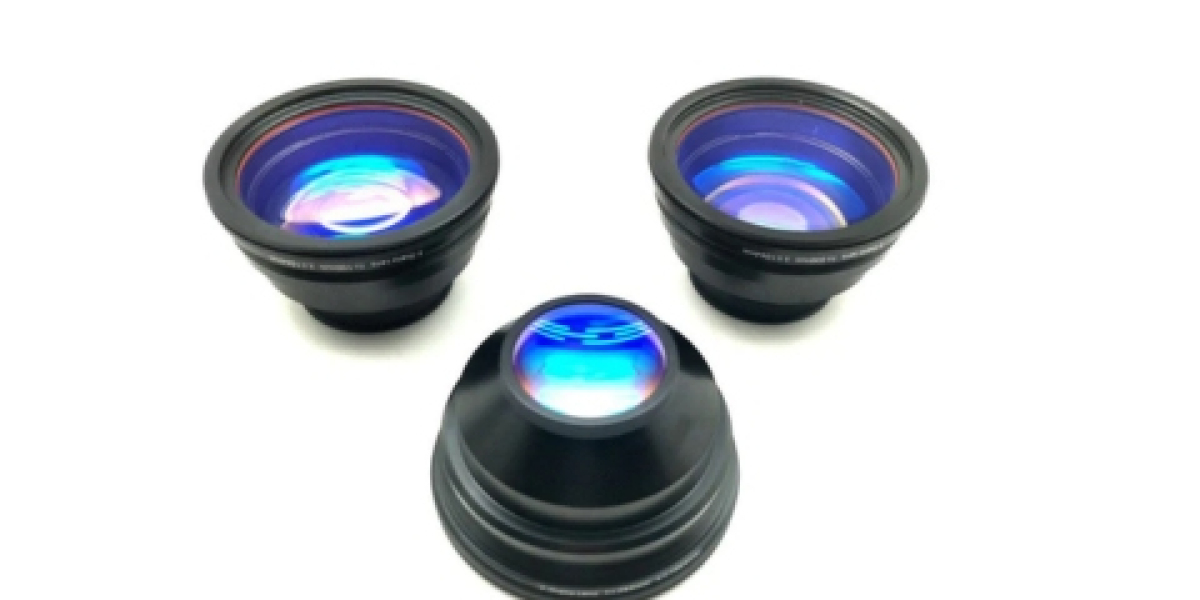In this guide, we’ll explore in detail how the fiber laser lens functions, what it impacts, and how poor lens management silently leads to production downtime, rising maintenance costs, and even irreversible machine damage. You’ll learn how the lens ties directly into process stability and what proper handling looks like in a high-throughput industrial environment.
What Is a Fiber Laser Lens and Why It Matters
The fiber laser lens is the optical component responsible for focusing the laser beam onto the work surface. This focused beam is what performs the cutting, engraving, or marking. A properly aligned, clean, and intact lens ensures a narrow beam diameter, optimal energy concentration, and consistent interaction with the material. Whether it’s metal, plastic, or ceramic, the final result is directly tied to the lens condition.
The lens is part of the optical path and is commonly found inside the laser head, between the collimator and the nozzle. Depending on the system design, you might be dealing with focusing lenses, collimating lenses, or protective lenses. Each one must be handled with a strict focus on cleanliness and alignment because any distortion or contamination directly degrades performance.
How a Dirty or Damaged Fiber Laser Lens Affects Your Operation
Many machine operators don't realize how fast a fiber laser lens can degrade if it isn’t cleaned regularly. Microscopic dust particles, spatter from material processing, or even oil from fingerprints can cause localized heating on the lens surface. This heating builds up over time, leading to thermal cracking or coating damage.
Once the lens is compromised:
The focus point becomes inconsistent.
Beam quality drops.
Processing speeds reduce.
Edge finishes become rough or incomplete.
Material penetration weakens.
And, eventually, the machine may throw an error or stop functioning.
In such cases, production halts. Orders delay. Downtime accumulates. And the loss isn't limited to repair costs — it spreads to labor hours, material wastage, and damaged customer relationships.
Why Many Operators Fail to Identify Lens Issues Early
One common reason for neglecting the fiber laser lens is that early lens damage doesn't always show up immediately in the product quality. You may still get acceptable cuts for a while. But beneath the surface, the optical beam is losing coherence. As this deterioration continues, the required energy to achieve the same cut increases, which puts more stress on the system. This snowballs into larger complications that could have been avoided with proactive inspection and lens replacement.
Another issue is lack of proper inspection tools. A high-magnification lens viewer or digital microscope can help detect contamination or micro-cracks that are invisible to the naked eye. But these tools aren’t always standard in industrial settings — leading to reactive maintenance rather than preventive action.
The Role of the Right Lens Type for Your Application
Not every fiber laser lens is universal. Applications differ in terms of laser power, wavelength, focal length, and beam delivery systems. For example:
High-power cutting applications often require multi-element focusing lenses with advanced coatings.
Fine marking or engraving systems may rely on smaller lenses with tighter focal tolerances.
If you mismatch the lens type to your application, beam delivery becomes inefficient. Even a high-end fiber laser machine won’t deliver optimal results with an incompatible or poorly installed lens.
That’s why suppliers typically specify the lens coating type (such as anti-reflective coatings optimized for 1064 nm) and focal distances. Always verify these before replacing or upgrading your lens to avoid unnecessary energy loss or beam distortion.
Cleaning and Handling: Best Practices to Extend Lens Life
You don’t need a full clean room to maintain your fiber laser lens, but you do need disciplined practices.
Here’s how professionals handle lens cleaning:
Use dedicated cleaning tools: Never use regular tissues or cloth. Only use optical-grade wipes and lens-specific cleaning solutions like acetone or isopropyl alcohol.
Apply gentle, circular motions: Aggressive rubbing can scratch the coating. Instead, lightly sweep the surface outward in a spiral.
Always wear gloves: Bare hands can leave oils that burn into the coating during operation.
Avoid compressed air from general-purpose cans: These may contain propellants that settle on the lens. Use filtered, clean air blowers designed for optics.
Perform visual inspection under bright, uniform light.
Even with the best care, lenses are consumables — they will eventually degrade. But with proper handling, the replacement cycle can be extended considerably.
When to Replace a Fiber Laser Lens
Knowing when to replace the fiber laser lens is crucial for uninterrupted operation. If you notice any of the following, a replacement is due:
Drop in cutting or marking quality despite correct machine settings.
Increase in power requirement to achieve the same depth.
Visible cracks, pitting, or discoloration on the lens.
Focus point shifts frequently or inconsistently.
Operators should schedule periodic lens checks based on operating hours and material types processed. In high-volume setups, daily inspections may be justified. For occasional users, weekly checks might suffice.
Avoid the mistake of waiting for full failure. A proactive replacement costs far less than fixing a broken optical chain.
Choosing a Quality Fiber Laser Lens Supplier
Not all third-party fiber laser lenses meet original specifications. That’s why it’s vital to choose a supplier that guarantees:
Compatibility with your laser model.
Precision-polished optics with consistent coating thickness.
Lens flatness, transmission rate, and tolerance within OEM limits.
Packaging that prevents contamination during shipping.
It’s also smart to keep spare lenses in a clean, temperature-controlled storage area. This way, your operation stays resilient against sudden failures.
The Silent Business Killer: Lens Negligence
Businesses that consistently underestimate the importance of their fiber laser lens pay the price in hidden ways. Lower throughput, excessive maintenance, and reduced product quality all stem from ignoring the lens. And when customers start noticing inconsistent results, the damage escalates from technical to reputational.
Treating the lens as an integral part of process optimization — not just another spare part — transforms operational efficiency. You’ll see faster cycles, cleaner results, and more consistent deliveries to clients.
Final Thoughts
The fiber laser lens isn’t just a part of the machine; it’s the heart of the optical system that determines performance, productivity, and profitability. Whether you're running a laser for metal cutting, engraving, or deep marking, lens condition plays a silent but powerful role in every pass of the beam. Stay vigilant, invest in regular inspections, use proper cleaning tools, and select high-quality replacements. The cost of lens care is minimal — the cost of neglect is far greater.

















